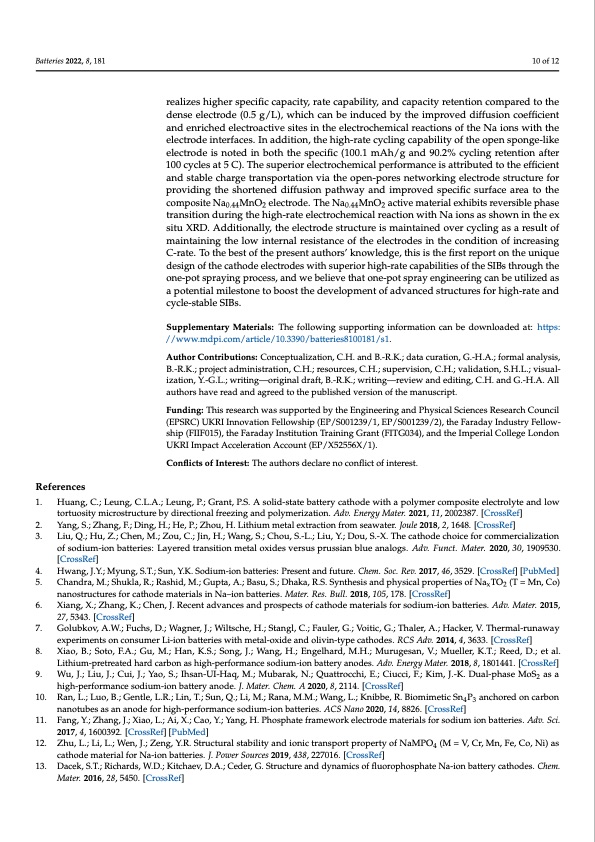
PDF Publication Title:
Text from PDF Page: 010
Batteries 2022, 8, 181 10 of 12 References realizes higher specific capacity, rate capability, and capacity retention compared to the dense electrode (0.5 g/L), which can be induced by the improved diffusion coefficient and enriched electroactive sites in the electrochemical reactions of the Na ions with the electrode interfaces. In addition, the high-rate cycling capability of the open sponge-like electrode is noted in both the specific (100.1 mAh/g and 90.2% cycling retention after 100 cycles at 5 C). The superior electrochemical performance is attributed to the efficient and stable charge transportation via the open-pores networking electrode structure for providing the shortened diffusion pathway and improved specific surface area to the composite Na0.44MnO2 electrode. The Na0.44MnO2 active material exhibits reversible phase transition during the high-rate electrochemical reaction with Na ions as shown in the ex situ XRD. Additionally, the electrode structure is maintained over cycling as a result of maintaining the low internal resistance of the electrodes in the condition of increasing C-rate. To the best of the present authors’ knowledge, this is the first report on the unique design of the cathode electrodes with superior high-rate capabilities of the SIBs through the one-pot spraying process, and we believe that one-pot spray engineering can be utilized as a potential milestone to boost the development of advanced structures for high-rate and cycle-stable SIBs. Supplementary Materials: The following supporting information can be downloaded at: https: //www.mdpi.com/article/10.3390/batteries8100181/s1. Author Contributions: Conceptualization, C.H. and B.-R.K.; data curation, G.-H.A.; formal analysis, B.-R.K.; project administration, C.H.; resources, C.H.; supervision, C.H.; validation, S.H.L.; visual- ization, Y.-G.L.; writing—original draft, B.-R.K.; writing—review and editing, C.H. and G.-H.A. All authors have read and agreed to the published version of the manuscript. Funding: This research was supported by the Engineering and Physical Sciences Research Council (EPSRC) UKRI Innovation Fellowship (EP/S001239/1, EP/S001239/2), the Faraday Industry Fellow- ship (FIIF015), the Faraday Institution Training Grant (FITG034), and the Imperial College London UKRI Impact Acceleration Account (EP/X52556X/1). Conflicts of Interest: The authors declare no conflict of interest. 1. Huang, C.; Leung, C.L.A.; Leung, P.; Grant, P.S. A solid-state battery cathode with a polymer composite electrolyte and low tortuosity microstructure by directional freezing and polymerization. Adv. Energy Mater. 2021, 11, 2002387. [CrossRef] 2. Yang, S.; Zhang, F.; Ding, H.; He, P.; Zhou, H. Lithium metal extraction from seawater. Joule 2018, 2, 1648. [CrossRef] 3. Liu, Q.; Hu, Z.; Chen, M.; Zou, C.; Jin, H.; Wang, S.; Chou, S.-L.; Liu, Y.; Dou, S.-X. The cathode choice for commercialization of sodium-ion batteries: Layered transition metal oxides versus prussian blue analogs. Adv. Funct. Mater. 2020, 30, 1909530. [CrossRef] 4. Hwang, J.Y.; Myung, S.T.; Sun, Y.K. Sodium-ion batteries: Present and future. Chem. Soc. Rev. 2017, 46, 3529. [CrossRef] [PubMed] 5. Chandra, M.; Shukla, R.; Rashid, M.; Gupta, A.; Basu, S.; Dhaka, R.S. Synthesis and physical properties of NaxTO2 (T = Mn, Co) nanostructures for cathode materials in Na–ion batteries. Mater. Res. Bull. 2018, 105, 178. [CrossRef] 6. Xiang, X.; Zhang, K.; Chen, J. Recent advances and prospects of cathode materials for sodium-ion batteries. Adv. Mater. 2015, 27, 5343. [CrossRef] 7. Golubkov, A.W.; Fuchs, D.; Wagner, J.; Wiltsche, H.; Stangl, C.; Fauler, G.; Voitic, G.; Thaler, A.; Hacker, V. Thermal-runaway experiments on consumer Li-ion batteries with metal-oxide and olivin-type cathodes. RCS Adv. 2014, 4, 3633. [CrossRef] 8. Xiao, B.; Soto, F.A.; Gu, M.; Han, K.S.; Song, J.; Wang, H.; Engelhard, M.H.; Murugesan, V.; Mueller, K.T.; Reed, D.; et al. Lithium-pretreated hard carbon as high-performance sodium-ion battery anodes. Adv. Energy Mater. 2018, 8, 1801441. [CrossRef] 9. Wu, J.; Liu, J.; Cui, J.; Yao, S.; Ihsan-UI-Haq, M.; Mubarak, N.; Quattrocchi, E.; Ciucci, F.; Kim, J.-K. Dual-phase MoS2 as a high-performance sodium-ion battery anode. J. Mater. Chem. A 2020, 8, 2114. [CrossRef] 10. Ran, L.; Luo, B.; Gentle, L.R.; Lin, T.; Sun, Q.; Li, M.; Rana, M.M.; Wang, L.; Knibbe, R. Biomimetic Sn4P3 anchored on carbon nanotubes as an anode for high-performance sodium-ion batteries. ACS Nano 2020, 14, 8826. [CrossRef] 11. Fang, Y.; Zhang, J.; Xiao, L.; Ai, X.; Cao, Y.; Yang, H. Phosphate framework electrode materials for sodium ion batteries. Adv. Sci. 2017, 4, 1600392. [CrossRef] [PubMed] 12. Zhu, L.; Li, L.; Wen, J.; Zeng, Y.R. Structural stability and ionic transport property of NaMPO4 (M = V, Cr, Mn, Fe, Co, Ni) as cathode material for Na-ion batteries. J. Power Sources 2019, 438, 227016. [CrossRef] 13. Dacek, S.T.; Richards, W.D.; Kitchaev, D.A.; Ceder, G. Structure and dynamics of fluorophosphate Na-ion battery cathodes. Chem. Mater. 2016, 28, 5450. [CrossRef]PDF Image | Cathode Electrodes High-Rate Cycle-Stable Na-Ion Batteries

PDF Search Title:
Cathode Electrodes High-Rate Cycle-Stable Na-Ion BatteriesOriginal File Name Searched:
batteries-08-00181-v3.pdfDIY PDF Search: Google It | Yahoo | Bing
Salgenx Redox Flow Battery Technology: Salt water flow battery technology with low cost and great energy density that can be used for power storage and thermal storage. Let us de-risk your production using our license. Our aqueous flow battery is less cost than Tesla Megapack and available faster. Redox flow battery. No membrane needed like with Vanadium, or Bromine. Salgenx flow battery
| CONTACT TEL: 608-238-6001 Email: greg@salgenx.com | RSS | AMP |